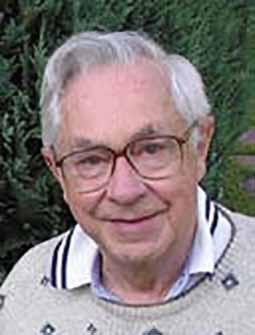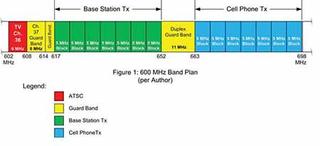FCC Reveals 600 MHz Band Plan

Charles W. Rhodes The FCC recently released some details of its 600 MHz band plan, the details of which are illustrated in Fig. 1. Previous versions by the FCC had a guard band between the lower end of the 700 MHz band and the data in the 600 MHz band.
That avoided interference to cellphone operation in the 700 MHz band, but that guard band is no longer needed because the signal at the upper end of the 600 MHz band was from base station transmitters, which have a maximum ERP of 720 Watts average power.
Now that part of the 600 MHz band will carry the emissions of cellphone transceivers (below 23 mW). Cellphones will cause much less interference than base stations and while base stations transmit continuously, cellphones transmit only occasionally.
In reviewing the plan, I noted that it provides seven 5 MHz blocks for up to seven LTE signals (the green sections in Fig. 1). One is for transmissions by the base station (617 MHz to 652 MHz) and the other (633 MHz to 698 MHz) is for transmissions by cellphones. This is a very flexible and economical band plan. In the auction, multiple blocks of this spectrum may be purchased by a successful bidder.
The LTE standard provides for these spectrum blocks: 1.5 MHz, 3 MHz, 5 MHz, 10 MHz, 15 MHz and 20 MHz. I believe that most of this spectrum will be blocks of 10 MHz each. There will be at least one 5 MHz block because the 35 MHz of two-way radio spectrum can be broken up into either one 5 MHz block and three 10 MHz blocks, or three 5 MHz blocks and two 10 MHz blocks, or five 5 MHz blocks and one 10 MHz block.
THE WHAT AND WHY OF GUARD BANDS

Fig. 1: The FCC’s new 600 MHz band plan DTV and LTE signals, as radiated, include out-of-band noise which is third order inter-modulation products (IM3) generated in the power amplifier of the transmitter. This adds noise in both upper and lower adjacent channels, limiting their value.
Guard bands are established by regulatory authorities—the FCC in the United States—to mitigate such interference. IM3 generated by a 5 MHz LTE block extends 5 MHz from the LTE signal. A 10 MHz wide LTE signal would have IM3 10 MHz wide.
In Fig. 1, there is a duplex guard band 11 MHz wide separating the base station spectrum from the cellphone spectrum, thus it protects against both 5 and 10 MHz LTE signals. Channel 37 is shown in yellow as it was never allocated for TV by international agreement. So it serves as a guard band, but it is too narrow (6 MHz) to protect against interference from a 10 MHz-wide LTE base station signal, so the FCC added 3 MHz (614 to 617 MHz) above channel 37, widening this guard band to 9 MHz. Guard bands are created only where needed because such spectrum cannot be used nor auctioned.
SOME MAJOR UNRESOLVED ISSUES REMAIN
Still unresolved is whether the FCC will adopt a uniform, nationwide plan that allocates the same spectrum of the 600 MHz band nationwide or to have different amounts of spectrum allocated to broadband in different parts of the country. In either case, the 600 MHz band spectrum starts at 698 MHz down as shown in Fig. 1. How much of the present UHF TV band will remain allocated to broadcast will depend on how many broadcasters volunteer their present spectrum for the auction and whether or not all that is volunteered for auction will be purchased. That will depend to some extent on other decisions yet to be made by the FCC.
Get the TV Tech Newsletter
The professional video industry's #1 source for news, trends and product and tech information. Sign up below.
For example, let us assume broadcasters volunteer enough licenses so that the present FCC 600 MHz band plan can be executed as shown in Fig. 1. Up to 35 MHz can be allocated for base station transmissions and another 35 MHz to cellphone transmissions. All of the 600 MHz band spectrum to be re-allocated is paired signals, one allotment for base stations, the other for cellphones.
If the FCC decides to implement a nationwide plan per Fig. 1, consider three stations that are up to roughly 80 miles apart. If the entire 35 MHz of paired spectrum in the 600 MHz band is allocated to Buffalo, N.Y., for example, then what about nearby communities? In the other extreme, seven communities including Buffalo could have two 5 MHz blocks each; or perhaps a 10 MHz block of spectrum will be allocated to each of two communities, with the third allocated to Buffalo. I cite Buffalo, N.Y. as an interesting case because of its proximity to Canada. The U.S. and Canadian governments must resolve these border issues, but to date negotiations are continuing.
Now let us say the FCC decides on a non-uniform plan which is preferred by the commission and opposed by many in the television broadcast industry. In one of our trio of communities let us allocate the 5 MHz blocks from 617 MHz to 623 MHz and 663 to 668 MHz. That means that this pair of blocks cannot be allowed in either of the other two communities because of adjacent channel interference and co-channel interference.
So we have some really major questions that must be answered before there can be an auction. Another is what happens to a station whose signal is picked up by a translator well outside of the station’s noise-limited coverage area. That station is providing a useful service to its viewers and is on a UHF channel as most are. If this channel is auctioned, must this translator shut down unless it can migrate to another suitable channel?
In looking very carefully at the FCC plan for the 600 MHz band, it occurred to me that there should not be any problem with interference by one (strong) base station signal between 617 and 652 MHz with TV reception. However, a second nearby base station and possibly a third may be all operating nearby in the 600 MHz band. If their combined power overloads TV receivers, third order distortion products would fall in channels 36, 35, 34, 32 and to a lesser extent, 32, depending on which blocks are in use. There is lots of data concerning DTV-DTV interference, but very little concerning LTE-DTV interference. A popular belief is that LTE is only a dB or so worse than ATSC as an interferer. I believe that more laboratory testing of LTE signals as interferers is the prudent approach.
Stay tuned.
Charles Rhodes is a consultant in the field of television broadcast technologies and planning. He can be reached via email atcwr@bootit.com.
